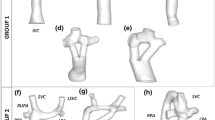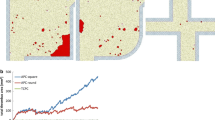Abstract
Single-ventricle anomaly is a hereditary heart disease that is characterized by anatomical malformations. The main consequence of this malformation is desaturated blood flow, which without proper treatment increases the risk of death. The classical treatment is based on a three-stage palliative procedure which should begin from the first few days of patient’s life. The final stage is known as Fontan procedure, in which inferior vena cava is directly connected to pulmonary arteries without going through the ventricle. This connection is called total cavopulmonary connection (TCPC). After surgery, the single ventricle supplies adequate and saturated systemic blood flow to the body; however, TCPC contains low pressure and low flow pulsatility. To overcome this problem, a new method is proposed wherein pulsatile blood will be directed to the TCPC through the stenosed main pulmonary artery. In this study, through the use of Computational Fluid Dynamics, T-shaped (MRI-based) and Y-shaped (computer-generated) geometries are compared in order to determine the influence of this modification on pulsation of blood flow as well as energy loss in pulmonary arteries. The results indicate that energy loss in Y-shaped geometry is far less than T-shaped geometry, while the difference in flow pulsatility is insignificant.










Similar content being viewed by others
Abbreviations
- TCPC:
-
Total cavopulmonary connection
- RPA:
-
Right pulmonary artery
- LPA:
-
Left pulmonary artery
- IVC:
-
Inferior vena cava
- SVC:
-
Superior vena cava
- PA:
-
Pulmonary artery
- PI:
-
Pulsatility index
- PF:
-
Pulsatile flow
- MRI:
-
Magnetic resonance imaging
- FSI:
-
Fluid structure interaction
References
Berdat PA, Belli E, Lacour-Gayet F, Planché C, Serraf A (2005) Additional pulmonary blood flow has no adverse effect on outcome after bidirectional cavopulmonary anastomosis. Ann Thorac Surg 79:29–36
de Zelicourt DA, Marsden A, Fogel MA, Yoganatham AP (2010) Imaging and patient-specific simulations for the Fontan surgery: Current methodologies and clinical applications. Progress Pediatric Cardiol 30:31–44
DeGroff C, Birnbaum B, Shandas R, Orlando W, Hertzberg J (2005) Computational simulations of the total cavo-pulmonary connection: insights in optimizing numerical solutions. Med Eng Phys 27:135–146
Fogel MA, Weinberg PM, Rychik J, Hubbard A, Jacobs M, Spray TL et al (1999) Caval contribution to flow in the branch pulmonary arteries of fontan patients with a novel application of magnetic resonance presaturation pulse. Circulation 99:1215–1221
Gersony WM (2008) Fontan operation after 3 decades what we have learned. Circulation 117:13–15
Ghoreyshi M, Saeidi MS, Nabavi MA, Firoozabadi B, Shabanian R (2012) Numerical investigation of antegrade flow effects on flow pulsations in Fontan operation. Int J Biomed Eng Technol 10
Gray RG, Altmann K, Mosca RS, Prakash A, Williams IA, Quaegebeur JM et al (2007) Persistent antegrade pulmonary blood flow post-glenn does not alter early post-Fontan outcomes in single-ventricle patients. Ann Thorac Surg 84:888–893
Hjortdal VE, Emmesten K, Stenbog E (2003) Effects of exercise and respiration on blood flow in total cavopulmonary connection: a real-time magnetic resonance flow study. Circulation 108:1227–1231
Hunter KS, Albietz JA, Lee PF, Lanning CJ, Lammers SR, Hofmeister SH et al (2010) In vivo measurement of proximal pulmonary artery elastic modulus in the neonatal calf model of pulmonary hypertension: development and ex vivo validation. J Appl Physiol 108:968–975
KrishnankuttyRema R, Dasi LP, Pekkan K, Sundareswaran K, Fogel M, Sharma S et al (2008) Quantitative analysis of extracardiac versus intraatrial fontan anatomic geometries. Ann Thorac Surg 85:810–817
Liu Y, Pekkan K, Jones SC, Yoganathan AP (2004) The effects of different mesh generation methods on computational fluid dynamic analysis and power loss assessment in total cavopulmonary connection. J Biomech Eng 126:594–603
Marsden AL, Vignon-Clementel IE, Chan FP, Feinstein JA, Taylor CA (2007) Effects of exercise and respiration on hemodynamic efficiency in CFD simulations of the total cavopulmonary connection. Ann Biomed Eng 35:250–263
Marsden AL, Bernstein AJ, Reddy VM, Shadden SC, Spilker RL, Chan FP et al (2009) Evaluation of a novel Y-shaped extracardiac Fontan baffle using computational fluid dynamics. J Thorac Cardiovasc Surgery 137:394–403.e2
Oghaz HR, Firoozabadi B, Saidi MS, Monjezi M, Navabi Shirazi MA, Malakan Rad E (2015) Evaluation of a novel extra-cardiac Fontan procedure with implantation of a biocompatible membrane. IRBM 36(5):287–292
Orlando W, Shandas R, DeGroff C (2006) Efficiency differences in computational simulations of the total cavo-pulmonary circulation with and without compliant vessel walls. Comput Methods Programs Biomed 81:220–227
Parker SE, Mai CT, Canfield MA, Rickard R, Wang Y, Meyer RE et al (2010) Updated national birth prevalence estimates for selected birth defects in the United States, 2004–2006. Birth Defects Res A 88:1008–1016
Pekkan K, Whited B, Kanter K, Sharma S, De Zelicourt DA, Sundareswaran K et al (2008) Patient-specific surgical planning and hemodynamic computational fluid dynamics optimization through free-form haptic anatomy editing tool (SURGEM). Med Biol Eng Comput 11:1139–1152
Rajabzadeh HR, Firoozabadi B, Saidi MS, Sohrabi S, Mehr SMN (2013) Numerical modeling of pulsating inflow to the pulmonary arteries in TCPC morphology using FSI approach. In: ASME 2013 International mechanical engineering congress and exposition, pp V03AT03A058–V03AT03A058
Silver FH, Snowhill PB, Foran DJ (2003) Mechanical behavior of vessel wall: a comparative study of aorta, vena cava, and carotid artery. Ann Biomed Eng 31:793–803
Throckmorton AL, Ballman KK, Myers CD, Frankel SH, Brown JW, Rodefeld MD (2008) Performance of a 3-bladed propeller pump to provide cavopulmonary assist in the failing Fontan circulation. Ann Thorac Surg 86:1343–1347
van de Wal HJCM, Ouknine R, Tamisier D, Levy M, Vouhe PR, Leca F (1999) Bi-directional cavopulmonary shunt: is accessory pulsatile flow, good or bad? Eur J Cardiothorac Surg 16:104–110
Whitehead KK, Sundareswaran KS, Park WJ, Harris MA, Yoganathan AP, Fogel MA (2009) Blood flow distribution in a large series of patients having the fontan operation: a cardiac magnetic resonance velocity mapping study. J Thorac Cardiovasc Surgery 138:96–102
Yang WG, Feinstein JA, Marsden AL (2010) Constrained optimization of an idealized Y-shaped baffle for the Fontan surgery at rest and exercise. Comput Meth App Mech Eng 199:2135–2149
Yoshida M, Yamaguchi M, Yoshimura N, Murakami H, Matsuhisa H, Okita Y (2005) Appropriate additional pulmonary blood flow at the bidirectional Glenn procedure is useful for completion of total cavopulmonary connection. Ann Thorac Surg 80:976–981
Author information
Authors and Affiliations
Corresponding author
Rights and permissions
About this article
Cite this article
Rajabzadeh-Oghaz, H., Firoozabadi, B., Saidi, M.S. et al. Pulsatile blood flow in total cavopulmonary connection: a comparison between Y-shaped and T-shaped geometry. Med Biol Eng Comput 55, 213–224 (2017). https://doi.org/10.1007/s11517-016-1499-4
Received:
Accepted:
Published:
Issue Date:
DOI: https://doi.org/10.1007/s11517-016-1499-4




